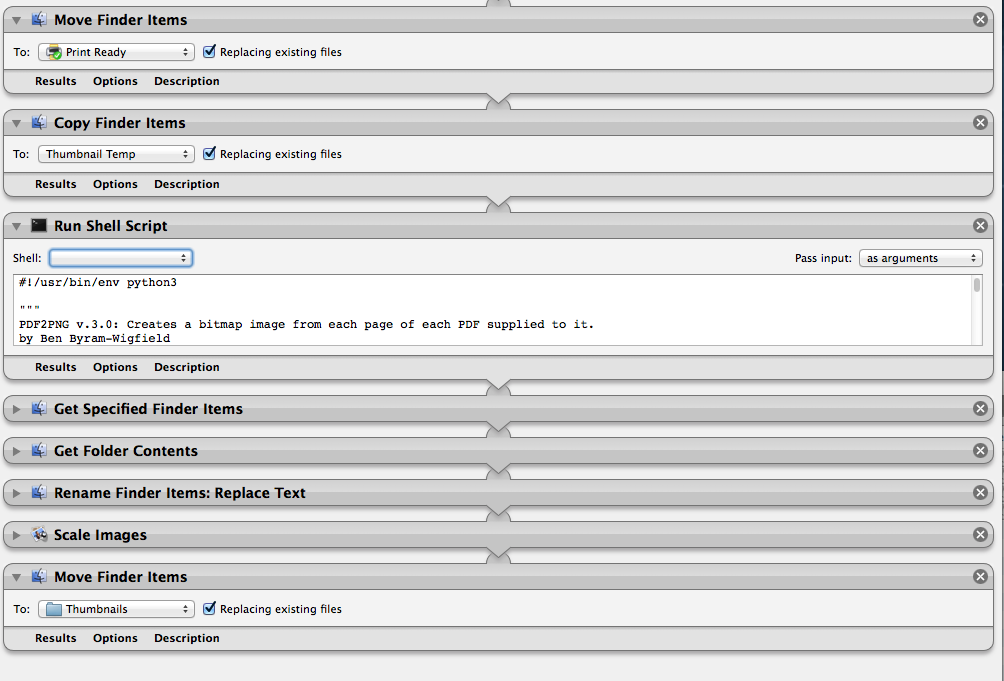I ended up hacking something together using an existing Python3 script, and duct taping it together in Automator.
I'm sure I'll be back here in a few years when Apple breaks it again, but I'll take the win.
If you drag and drop a pdf onto the application, it moves the file to another folder, then creates a copy of it in another folder, then converts it to a png of the 1st page from the pdf using the exact same name except *.png, then moves the png to it's final folder.
It's not pretty, but if anyone needs it, it works.
Here's the Python3 script after I finished butchering it.
(I'm sure there's plenty of stuff in there that doesn't need to be there, but it's working, so I'm gonna quit while I'm ahead)
#!/usr/bin/env python3
"""
PDF2PNG v.3.0: Creates a bitmap image from each page of each PDF supplied to it.
by Ben Byram-Wigfield
Now written for python3. You may need to install pyobjc with pip3.
"""
import os, sys
import Quartz as Quartz
# from LaunchServices import (kUTTypeJPEG, kUTTypeTIFF, kUTTypePNG, kCFAllocatorDefault)
kUTTypeJPEG = 'public.jpeg'
kUTTypeTIFF = 'public.tiff'
kUTTypePNG = 'public.png'
kCFAllocatorDefault = None
resolution = 300.0 #dpi
scale = resolution/72.0
cs = Quartz.CGColorSpaceCreateWithName(Quartz.kCGColorSpaceSRGB)
whiteColor = Quartz.CGColorCreate(cs, (1, 1, 1, 1))
# Options: Quartz.kCGImageAlphaNoneSkipLast (no trans), Quartz.kCGImageAlphaPremultipliedLast
transparency = Quartz.kCGImageAlphaNoneSkipLast
#Save image to file
def writeImage (image, url, type, options):
destination = Quartz.CGImageDestinationCreateWithURL(url, type, 1, None)
Quartz.CGImageDestinationAddImage(destination, image, options)
Quartz.CGImageDestinationFinalize(destination)
return
if __name__ == '__main__':
for filename in sys.argv[1:]:
filenameNonU = filename.encode('utf8')
pdf = Quartz.CGPDFDocumentCreateWithProvider(Quartz.CGDataProviderCreateWithFilename(filenameNonU))
print(filenameNonU)
numPages = Quartz.CGPDFDocumentGetNumberOfPages(pdf)
shortName = os.path.splitext(filename)[0]
prefix = os.path.splitext(os.path.basename(filename))[0]
# For each page, create a file
for i in range (1, numPages+0):
page = Quartz.CGPDFDocumentGetPage(pdf, i)
if page:
#Get mediabox
mediaBox = Quartz.CGPDFPageGetBoxRect(page, Quartz.kCGPDFMediaBox)
x = Quartz.CGRectGetWidth(mediaBox)
y = Quartz.CGRectGetHeight(mediaBox)
x *= scale
y *= scale
r = Quartz.CGRectMake(0,0,x, y)
# Create a Bitmap Context, draw a white background and add the PDF
writeContext = Quartz.CGBitmapContextCreate(None, int(x), int(y), 8, 0, cs, transparency)
Quartz.CGContextSaveGState (writeContext)
Quartz.CGContextScaleCTM(writeContext, scale,scale)
Quartz.CGContextSetFillColorWithColor(writeContext, whiteColor)
Quartz.CGContextFillRect(writeContext, r)
Quartz.CGContextDrawPDFPage(writeContext, page)
Quartz.CGContextRestoreGState(writeContext)
# Convert to an "Image"
image = Quartz.CGBitmapContextCreateImage(writeContext)
# Create unique filename per page
outFile = filename
outFile_nonU = outFile.encode('utf8')
url = Quartz.CFURLCreateFromFileSystemRepresentation(kCFAllocatorDefault, outFile_nonU, len(outFile_nonU), False)
# kUTTypeJPEG, kUTTypeTIFF, kUTTypePNG
type = kUTTypePNG
# See the full range of image properties on Apple's developer pages.
options = {
Quartz.kCGImagePropertyDPIHeight: resolution,
Quartz.kCGImagePropertyDPIWidth: resolution
}
writeImage (image, url, type, options)
del page
And here's the complete Automator workflow.
(The Shell dropdown under Run Shell Script is blank because I'm on a different computer which doesn't have Python3, but it should have the python3 path selected there to work)


